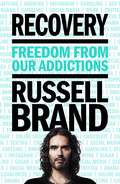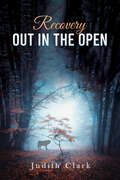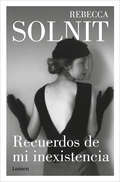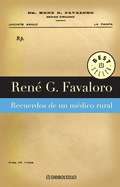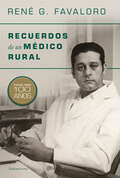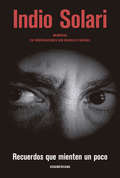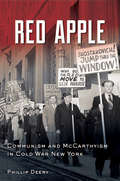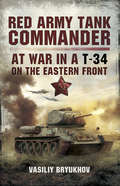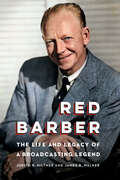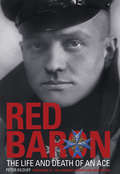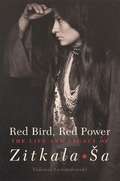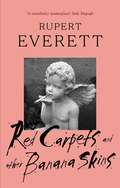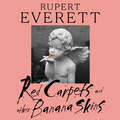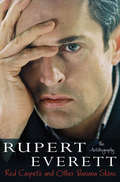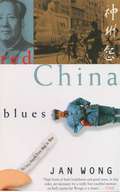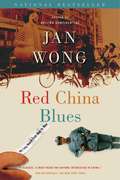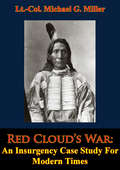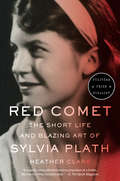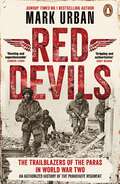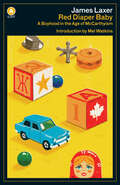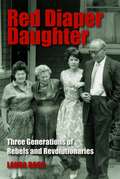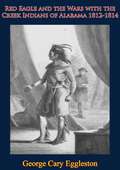- Table View
- List View
Recovery: Freedom from Our Addictions
by Russell Brand<P>A guide to all kinds of addiction from a star who has struggled with heroin, alcohol, sex, fame, food and eBay, that will help addicts and their loved ones make the first steps into recovery. <P>“This manual for self-realization comes not from a mountain but from the mud...My qualification is not that I am better than you but I am worse.” —Russell Brand <P>With a rare mix of honesty, humor, and compassion, comedian and movie star Russell Brand mines his own wild story and shares the advice and wisdom he has gained through his fourteen years of recovery. Brand speaks to those suffering along the full spectrum of addiction—from drugs, alcohol, caffeine, and sugar addictions to addictions to work, stress, bad relationships, digital media, and fame. <P>Brand understands that addiction can take many shapes and sizes and how the process of staying clean, sane, and unhooked is a daily activity. He believes that the question is not “Why are you addicted?” but "What pain is your addiction masking? Why are you running—into the wrong job, the wrong life, the wrong person’s arms?" <P>Russell has been in all the twelve-step fellowships going, he’s started his own men’s group, he’s a therapy regular and a practiced yogi—and while he’s worked on this material as part of his comedy and previous bestsellers, he’s never before shared the tools that really took him out of it, that keep him clean and clear. Here he provides not only a recovery plan, but an attempt to make sense of the ailing world. <P><b>A New York Times Bestseller</b>
Recovery: Out in the Open
by Judith ClarkAre you someone who is struggling to feel comfortable in your own skin? Please pick up this book. Are you someone who knows deep down that ‘there is more to life than this’? Please pick up this book. Are you struggling to find hope? Please pick up this book. When you are alone, you still can’t stand the company? Well, that’s brilliant! At least we know where to begin. Thank everything, and despite everything, you picked up this book.
Recuerdos de mi inexistencia
by Rebecca SolnitEl libro más esperado de la gran pensadora feminista, autora de Los hombres me explican cosas: un memoir iluminador sobre su educación sentimental y social. UNO DE LOS 100 LIBROS QUE HAY QUE LEER SEGÚN TIME «Para Solnit, la esperanza no es una garantía para el mañana, sino un detonador para la acción de hoy.»John Berger En 1981, una jovencísima Rebecca Solnit se mudaba a su primer apartamento en un barrio marginal de San Francisco. En él pasaría los siguientes veinticinco años, librando feroces batallas para llevar a cabo la difícil tarea de construir su identidad y tomar la palabra en una sociedad que agrede y silencia a las mujeres.Recuerdos de mi inexistencia, su último libro y suprimer memoir, aclamado por la crítica y los lectores en Estados Unidos, marca un hito y «nos da la clave para comprender toda su obra» (The New York Times). Estas páginas narran la emocionante historia de iniciación de «una escritora única, cuya esperanzadora voz es, ahora más que nunca, esencial» (The Guardian): «la voz de la resistencia» (The New York Times Magazine). La crítica ha dicho...«Una ensayista elegante. Traspasa con alegría los límites de las disciplinas y del género, marcando el camino de la filosofía, la paleontología, la política, la religión y la crítica literaria.»The New York Times «Mucho más que un manifiesto feminista. [...] Leer a Solnit es rozar emociones e intuiciones que uno apenas identifica.»Katy Waldman, The New Yorker «Consigue atrapar al lector [...] porque hace de lo íntimo algo universal.»Carolina Isasi, Zenda «Solnit reivindica la apertura de mente, aventurarse más allá de lo conocido, el tropiezo con lo que no se había previsto.»Olga Merino, El Periódico «El que expone Solnit es un “nuevo feminismo”, radical y expresado con lexemas de simpatía, que no se desentiende de las luchas del siglo XX.»Manuel Rivas, El País Semanal «El genio de Solnit [...] consiste en hacernos mirar lo que ya hemos visto y verlo de otra manera.»Marta Peirano, eldiario.es «Una de las voces más poderosas del feminismo, remite irremediablemente a escritoras también polémicas como Susan Sontag o Joan Didion.»Déborah Camañes, Encuentros (Diari de Tarragona) «Un poderoso análisis de cómo los pequeños momentos se acumulan en una mente brillante para formular grandes ideas.»Lorraine Berry, Los Angeles Times «Las palabras de Solnit alientan el anhelo de un mundo mejor.»Toni Montesinos, La Razón
Recuerdos de un médico rural
by Rene FavaloroFavaloro analiza y describe su actividad como médico rural en un pueblodel oeste pampeano. Entre mediados de la década del 50 y principios del 62, René Favaloro,el médico más reconocido de la Argentina, trabajó como médico rural.Estos 12 años de trabajo fueron los que más lo marcaron, tanto en suvida profesional, como en su vida personal.El mismo médico que se volverá una eminencia años después en Cleveland,trabajando con los profesionales más destacados de la medicinainternacional, inició su carrera profesional en el interior de laArgentina, y fue esa base de trabajo, lo que más marcó su vocación.La reedición de este libro era muy importante para los lectores porqueFavaloro es una de las figuras más destacadas y queridas de nuestropaís.
Recuerdos de un médico rural: Favaloro 100 años
by Rene FavaloroNueva edición por el 100 aniversario del nacimiento del Dr. Favaloro. Uno de los médicos más reconocidos del país rememora sus experiencias como médico en un pueblo del oeste pampeano y reflexiona sobre las condiciones en las que se ejerce su profesión en la Argentina. Entre comienzos de la década del 50 y 1962, René Favaloro se desempeñó como médico rural en el pueblo pampeano de Jacinto Aráuz. Estos doce años fueron los que lo definieron, tanto en su vida profesional como en la personal. El mismo doctor que se volverá una eminencia años después en Cleveland, trabajando con los profesionales más destacados de la medicina internacional, inició su carrera en el interior de la Argentina, y fue esa labor lo que más marcó su vocación. En 1980 publicó esta obra, su primer libro autobiográfico. En él reflexionó acerca de su propia experiencia y del ejercicio de la medicina en algunas zonas postergadas del país, a la vez que advirtió sobre el devenir de la práctica pública de la salud y cierta decadencia en la formación de nuevos médicos. Recuerdos de un médico rural tuvo un gran recibimiento. "Mi objetivo -decía en el prólogo a la segunda edición, que escribió emocionado por las cartas que le habían enviado cole - gas y maestros rurales que se sintieron representados en sus escritos- no es presentar la simple descripción de hechos anecdóticos sino, a través de ellos, mostrar las condiciones socioeconómicas del interior". Y se preguntaba: "¿Tendremos capacidad de reaccionar? ¿Seremos capaces de realizar la verdadera reconstrucción?".
Recuerdos que mienten un poco: Memorias. En conversaciones con Marcelo Figueras
by Indio SolariLas memorias del Indio Solari, creador y líder de Patricio Rey y sus Redonditos de Ricota, desde sus orígenes en Paraná hace 70 años hasta hoy, atravesando la historia de sus bandas disco por disco, sus comienzos, sus influencias, su independencia militante, su compleja relación con los medios, sus polémicas, y su presente personal y artístico. La primera autobiografía completa y en primera persona de Carlos Alberto "El Indio" Solari (Paraná, 1949), fundador junto con Skay Beilinson de Patricio Rey y sus Redonditos de Ricota. Mediante el recorrido de su vida y una obra (sus influencias y sus temas) que lo convirtió en icono de la escena contracultural del rock argentino, nos acercamos al contenido de sus letras y sus melodías, sus ídolos, la relación con su público y con la prensa (su renuencia a aparecer en medios masivos), con sus compañeros de bandas y también con los músicos de su generación. Atravesando su trayectoria junto a los Redondos hasta la disolución en 2001; la historia de los cuatro discos que grabó con su nuevo grupo, Los Fundamentalistas del Aire Acondicionado, y su presente -ahora que ha aceptado hablar públicamente sobre su enfermedad-, el Indio, el artista militante del NO-TELEVISIÓN, lo cuenta todo.
Red Apple: Communism and McCarthyism in Cold War New York
by Phillip DeeryFrom the late 1940s through the 1950s, McCarthyism disfigured the American political landscape. Under the altar of anticommunism, domestic Cold War crusaders undermined civil liberties, curtailed equality before the law, and tarnished the ideals of American democracy. In order to preserve freedom, they jettisoned some of its tenets. Congressional committees worked in tandem, although not necessarily in collusion, with the FBI, law firms, university administrations, publishing houses, television networks, movie studios, and a legion of government agencies at the federal, state, and local levels to target “subversive” individuals. Exploring the human consequences of the widespread paranoia that gripped a nation, Red Apple presents the international and domestic context for the experiences of these individuals: the House Un-American Activities Committee, hearings of the Joint Anti-Fascist Refugee Committee, resulting in the incarceration of its chairman, Dr. Edward Barsky, and its executive board; the academic freedom cases of two New York University professors, Lyman Bradley and Edwin Burgum, culminating in their dismissal from the university; the blacklisting of the communist writer Howard Fast and his defection from American communism; the visit of an anguished Dimitri Shostakovich to New York in the spring of 1949; and the attempts by O. John Rogge, the Committee’s lawyer, to find a “third way” in the quest for peace, which led detractors to question which side he was on. Examining real-life experiences at the “ground level,” Deery explores how these six individuals experienced, responded to, and suffered from one of the most savage assaults on civil liberties in American history. Their collective stories illuminate the personal costs of holding dissident political beliefs in the face of intolerance and moral panic that is as relevant today as it was seventy years ago.
Red Army Tank Commander: At War in a T-34 on the Eastern Front
by Vasiliy BryukhovA vivid firsthand account of armored warfare by a WWII Soviet tank commander. What was it like to command a T-34 tank on the Eastern Front during the Second World War? How were tank operations organized and carried out, what was the actual experience of combat, and what were the qualities that made the difference between success and failure? And what were the chances of survival? Vasiliy Pavlovich Bryukhov&’s vivid, detailed, and gripping memoir of his wartime service gives a fascinating and authentic insight into these questions. It also provides an accurate, unsentimental record of the day-to-day life of a tankman whose unit fought in the forefront of the Red Army throughout the conflict across the western Soviet Union and into eastern Europe. His first-hand eyewitness account is a memorable personal story that provides a powerful insight into the reality of tank warfare seventy-five years ago.
Red Azalea
by Anchee MinRed Azalea is Anchee Min's celebrated memoir of growing up in the last years of Mao's China. As a child, she was asked to publicly humiliate a teacher; at seventeen, she was sent to work at a labor collective. Forbidden to speak, dress, read, write, or love as she pleased, she found a lifeline in a secret love affair with another woman. Miraculously selected for the film version of one of Madame Mao's political operas, Min's life changed overnight. Then Chairman Mao suddenly died, taking with him an entire world. A revelatory and disturbing portrait of China, Anchee Min's memoir is exceptional for its candor, its poignancy, its courage, and for its prose which Newsweek calls "as delicate and evocative as a traditional Chinese brush painting."From the Trade Paperback edition.
Red Barber: The Life and Legacy of a Broadcasting Legend
by James R. Walker Judith R. HiltnerBorn and raised in rural Mississippi and the even balmier climes of central Florida, Red Barber, at the age of thirty-two, became one of New York City&’s most influential citizens as the play-by-play announcer for the Brooklyn Dodgers. When he arrived in 1939, Barber brought the down-home drawl and idioms of his southern roots to the borough, where residents said they could walk down any street and never miss a pitch because his voice wafted out of every window and every passing car. From his colorful expressions like &“rhubarb&” and &“sitting in the catbird seat&” to his vivid use of similes—a close game was &“tighter than a new pair of shoes on a rainy day&”—Barber&’s influence on his contemporaries and the many generations of broadcasters who followed him cannot be overstated. But behind all the base hits, balls, and strikes lies a compelling story that dramatizes the shifting expectations and roles of a public figure—the sports broadcaster—as he adapted to complex cultural changes throughout the course of twentieth-century American life.Red Barber follows the trajectory of Barber's long career from radio and television play-by-play man for the Cincinnati Reds, Brooklyn Dodgers, and New York Yankees to his work calling college and professional football games, his nine-year tenure as director of sports for CBS Radio, and his second acts as an Episcopal lay reader, sportswriter, and weekly guest with Bob Edwards on NPR&’s Morning Edition. This talented public figure was also a private man committed to rigorous self-examination and willing to evolve and grow under the influence of changing times. When the Dodgers first signed Jackie Robinson and smashed the color barrier in Major League Baseball, Barber struggled to overcome the racism he had absorbed from his culture as a child. But after observing the vicious abuse Robinson endured from opposing fans, Barber became an ardent supporter of him and the many Black players who followed. Barber was also bothered deeply by the strains that his single-minded careerism imposed on his family. He was challenged to navigate longtime family tensions after his only child, Sarah, came out as a lesbian. And his primary role during the later years of his life was caretaking for his wife, Lylah, during her decline from Alzheimer&’s disease, at a time when the ailment was something many families concealed. Ultimately Red Barber traces the career of a true radio and television pioneer who was committed to the civic responsibility of mass media. Barber firmly believed the most important role of a broadcaster was telling the truth and promoting public well-being.
Red Baron: The Life And Death Of An Ace
by Peter KilduffManfred Freiherr von Richthofen, the Red Baron, was the most successful fighter pilot of World War I, shooting down 80 enemy airplanes and receiving more high decorations than any other German combatant.In Red Baron: The Life and Death of an Ace, Peter Kilduff tells the story of this courageous and charismatic man: his comrades and enemies, the planes he flew, the battles he fought in, the political climate that caused his eventual disenchantment and the controversial circumstances of his death.Containing previously unpublished photographs, drawings on new source material from former East German state archives and making fresh insights into existing sources, Red Baron is the most up-to-date reference on the life of a legend.
Red Bird, Red Power: The Life and Legacy of Zitkala-Sa (American Indian Literature and Critical Studies Ser. #67)
by Tadeusz LewandowskiRed Bird, Red Power tells the story of one of the most influential—and controversial—American Indian activists of the twentieth century. Zitkala-Ša (1876–1938), also known as Gertrude Simmons Bonnin, was a highly gifted writer, editor, and musician who dedicated her life to achieving justice for Native peoples. Here, Tadeusz Lewandowski offers the first full-scale biography of the woman whose passionate commitment to improving the lives of her people propelled her to the forefront of Progressive-era reform movements. <P><P>Lewandowski draws on a vast array of sources, including previously unpublished letters and diaries, to recount Zitkala-Ša’s unique life journey. Her story begins on the Dakota plains, where she was born to a Yankton Sioux mother and a white father. Zitkala-Ša, whose name translates as “Red Bird” in English, left home at age eight to attend a Quaker boarding school, eventually working as a teacher at Carlisle Indian Industrial School. By her early twenties, she was the toast of East Coast literary society. Her short stories for the Atlantic Monthly (1900) are, to this day, the focus of scholarly analysis and debate. In collaboration with William F. Hanson, she wrote the libretto and songs for the innovative Sun Dance Opera (1913). <P><P>And yet, as Lewandowski demonstrates, Zitkala-Ša’s successes could not fill the void of her lost cultural heritage, nor dampen her fury toward the Euro-American establishment that had robbed her people of their land. In 1926, she founded the National Council of American Indians with the aim of redressing American Indian grievances. <P><P>Zitkala-Ša’s complex identity has made her an intriguing—if elusive—subject for scholars. In Lewandowski’s sensitive interpretation, she emerges as a multifaceted human being whose work entailed constant negotiation. In the end, Lewandowski argues, Zitkala-Ša’s achievements distinguish her as a forerunner of the Red Power movement and an important agent of change.
Red Brick, Black Mountain, White Clay: Reflections on Art, Family, and Survival
by Christopher Benfey"Beautiful, haunted, evocative and so open to where memory takes you. I kept thinking that this is the book that I have waited for: where objects, and poetry intertwine. Just wonderful and completely sui generis. " (Edmund de Waal, author of The Hare with Amber Eyes) An unforgettable voyage across the reaches of America and the depths of memory, this generational memoir of one incredible family reveals America’s unique craft tradition. In Red Brick, Black Mountain, White Clay, renowned critic Christopher Benfey shares stories—of his mother’s upbringing in rural North Carolina among centuries-old folk potteries; of his father’s escape from Nazi Europe; of his great-aunt and -uncle Josef and Anni Albers, famed Bauhaus artists exiled at Black Mountain College—unearthing an ancestry, and an aesthetic, that is quintessentially American. With the grace of a novelist and the eye of a historian, Benfey threads these stories together into a radiant and mesmerizing harmony. .
Red Carpets And Other Banana Skins
by Rupert Everett''Hilariously honest. . . a kind of rake's progress' Daily MailAn element of drama has always attended Rupert Everett, even before he swept to fame with his outstanding performance in 'Another Country'. He has spent his life surrounded by extraordinary people, and witnessed extraordinary events. He was in Moscow during the fall of communism; in Berlin the night the wall came down; and in downtown Manhattan on September 11th. By the age of 17 he was friends with Andy Warhol and Bianca Jagger, and since then he has been up close and personal with some of the most famous women in the world: Julia Roberts, Madonna, Sharon Stone and Donatella Versace. Whether sweeping the floor for the Royal Shakespeare Company or co-starring with Faye Dunaway and an orang-utan in 'Dunstan Checks In' (they both took ages to get ready), Rupert Everett always brings as much energy and talent to his life as he does to his career. A superb raconteur and a keen observer of human folly (especially his own), Rupert Everett turns his life into a captivating story of love, fame, glamour, gossip and drama.Praise for Red Carpets and Other Banana Skins'He has an almost fanatical loyalty to the concept of enjoyment, to the detriment, it might be argued, of his art, though to the great enrichment of his being; and for Rupert, as he makes clear in this continuously brilliant memoir, the best theatrical autobiography since Noël Coward's Present Indicative, acting is being...a superb and unexpectedly inspiring achievement' Simon Callow, Guardian'Lush, profoundly reflective, and thoroughly satisfying...a heady triumph of observation and reverie' Independent'What makes this autobiography a (novelistic) masterpiece is the way he is acutely aware of the melancholia and pain that are the other side of hedonism's coin' Daily Telegraph
Red Carpets And Other Banana Skins
by Rupert Everett''Hilariously honest. . . a kind of rake's progress' Daily MailAn element of drama has always attended Rupert Everett, even before he swept to fame with his outstanding performance in 'Another Country'. He has spent his life surrounded by extraordinary people, and witnessed extraordinary events. He was in Moscow during the fall of communism; in Berlin the night the wall came down; and in downtown Manhattan on September 11th. By the age of 17 he was friends with Andy Warhol and Bianca Jagger, and since then he has been up close and personal with some of the most famous women in the world: Julia Roberts, Madonna, Sharon Stone and Donatella Versace. Whether sweeping the floor for the Royal Shakespeare Company or co-starring with Faye Dunaway and an orang-utan in 'Dunstan Checks In' (they both took ages to get ready), Rupert Everett always brings as much energy and talent to his life as he does to his career. A superb raconteur and a keen observer of human folly (especially his own), Rupert Everett turns his life into a captivating story of love, fame, glamour, gossip and drama.Praise for Red Carpets and Other Banana Skins'He has an almost fanatical loyalty to the concept of enjoyment, to the detriment, it might be argued, of his art, though to the great enrichment of his being; and for Rupert, as he makes clear in this continuously brilliant memoir, the best theatrical autobiography since Noël Coward's Present Indicative, acting is being...a superb and unexpectedly inspiring achievement' Simon Callow, Guardian'Lush, profoundly reflective, and thoroughly satisfying...a heady triumph of observation and reverie' Independent'What makes this autobiography a (novelistic) masterpiece is the way he is acutely aware of the melancholia and pain that are the other side of hedonism's coin' Daily Telegraph
Red Carpets and Other Banana Skins: The Autobiography
by Rupert EverettRevealing himself to be a consummate storyteller, stage and screen star Everett ("My Best Friend's Wedding") pens a delightfully witty memoir in which he reveals his life experiences as an up-and-coming actor, detailing everything from the eccentricities of the British upper class to the madness of Hollywood.
Red China Blues: My Long March From Mao to Now
by Jan WongJan Wong, a Canadian of Chinese descent, went to China as a starry-eyed Maoist in 1972 at the height of the Cultural Revolution. A true believer--and one of only two Westerners permitted to enroll at Beijing University--her education included wielding a pneumatic drill at the Number One Machine Tool Factory. In the name of the Revolution, she renounced rock & roll, hauled pig manure in the paddy fields, and turned in a fellow student who sought her help in getting to the United States. She also met and married the only American draft dodger from the Vietnam War to seek asylum in China.Red China Blues is Wong's startling--and ironic--memoir of her rocky six-year romance with Maoism (which crumbled as she became aware of the harsh realities of Chinese communism); her dramatic firsthand account of the devastating Tiananmen Square uprising; and her engaging portrait of the individuals and events she covered as a correspondent in China during the tumultuous era of capitalist reform under Deng Xiaoping. In a frank, captivating, deeply personal narrative she relates the horrors that led to her disillusionment with the "worker's paradise." And through the stories of the people--an unhappy young woman who was sold into marriage, China's most famous dissident, a doctor who lengthens penises--Wong reveals long-hidden dimensions of the world's most populous nation.In setting out to show readers in the Western world what life is like in China, and why we should care, she reacquaints herself with the old friends--and enemies of her radical past, and comes to terms with the legacy of her ancestral homeland.From the Trade Paperback edition.
Red China Blues: My Long March from Mao to Now
by Jan WongJan Wong, a Canadian of Chinese descent, went to China as a starry-eyed Maoist in 1972 at the height of the Cultural Revolution. A true believer -- and one of only two Westerners permitted to enroll at Beijing University -- her education included wielding a pneumatic drill at the Number One Machine Tool Factory. In the name of the Revolution, she renounced rock and roll, hauled pig manure in the paddy fields, and turned in a fellow student who sought her help in getting to the United States. She also met and married the only American draft dodger from the Vietnam War to seek asylum in China. Red China Blues begins as Wong's startling -- and ironic -- memoir of her rocky six-year romance with Maoism that began to sour as she became aware of the harsh realities of Chinese communism and led to her eventual repatriation to the West. Returning to China in the late eighties as a journalist, she covered both the brutal Tiananmen Square crackdown and the tumultuous era of capitalist reforms under Deng Xiaoping. In a wry, absorbing, and often surreal narrative, she relates the horrors that led to her disillusionment with the "worker's paradise." And through the stories of the people -- an unhappy young woman who was sold into marriage, China's most famous dissident, a doctor who lengthens penises -- Wong creates an extraordinary portrait of the world's most populous nation. In setting out to show readers in the Western world what life is like in China, and why we should care, Wong reacquaints herself with the old friends -- and enemies -- of her radical past, and comes to terms with the legacies of her ancestral homeland.
Red Cloud: A Lakota Story of War and Surrender
by S. D. Nelson“Readers will appreciate this complex look at Chief Red Cloud, who under duress, unimaginable trauma, and starvation made a difficult choice.” —School Library Journal (starred review)Red Cloud (1822–1909) was a great warrior and chief of the Lakota. Told from his perspective, Red Cloud: A Lakota Story of War and Surrender describes the events that brought him to prominence as a leader of his people and how he came to surrender them to the wasichus (White Man), ending their way of life on the Great Plains.From the intrusion of white settlers into Lakota territory, to the treaties signed with the U.S. government, and to the many subsequent battles, Red Cloud explains how the Lakota became the only nation to win a war against the U.S. Army on American soil. However, unlike fellow warriors Crazy Horse and Sitting Bull, Red Cloud eventually came to accept the inevitable advance of white civilization. He submitted to change and moved his followers onto a reservation. The story concludes with Red Cloud’s trip to the East Coast, where he visited New York City and met President Ulysses S. Grant.Award-winning author and member of the Standing Rock Sioux tribe S. D. Nelson reinterprets the nineteenth-century Lakota ledger-art style to give authenticity to the story as he brings to light one of the most controversial members of the Lakota tribe, Red Cloud. Backmatter includes a timeline.“An impressive amount of information movingly and handsomely conveyed.” —Kirkus Reviews (starred review)“The story, at once inspiring and sad, is expanded and enriched by Nelson’s beautiful ink, watercolor, and colored-pencil illustrations executed in the nineteenth-century Lakota ledger-book style.” —Booklist (starred review)
Red Cloud’s War: An Insurgency Case Study For Modern Times
by Lt.-Col. Michael G. MillerThis will be a case study of the little known Fetterman Massacre of 1866. It will look the situation at the time, possible causes, key players, the massacre itself and the aftermath. Similarities to the counterinsurgency in Afghanistan will be noted where applicable throughout this paper. A case will be proposed that the Army was ill prepared for the Indian Wars of the latter 19th Century, just as they were initially ill prepared for an extended Afghanistan Insurgency Campaign. Connections are drawn showing that there were lessons learned in 1866 that are still appropriate today. Familiarity with them, along with other more recent examples, will better prepare the Army to fight counterinsurgencies in the future.
Red Comet: The Short Life and Blazing Art of Sylvia Plath
by Heather Clark&“Finally, the biography that Sylvia Plath deserves . . . A spectacular achievement.&” —Ruth Franklin, author of Shirley Jackson: A Rather Haunted LifeThe highly anticipated new biography of Sylvia Plath that focuses on her remarkable literary and intellectual achievements, while restoring the woman behind the long-held myths about her life and art.With a wealth of never-before-accessed materials--including unpublished letters and manuscripts; court, police, and psychiatric records; and new interviews--Heather Clark brings to life the brilliant daughter of Wellesley, Massachusetts who had poetic ambition from a very young age and was an accomplished, published writer of poems and stories even before she became a star English student at Smith College in the early 1950s. Determined not to read Plath's work as if her every act, from childhood on, was a harbinger of her tragic fate, Clark evokes a culture in transition, in the shadow of the atom bomb and the Holocaust, as she explores Plath's world: her early relationships and determination not to become a conventional woman and wife; her conflicted ties to her well-meaning, widowed mother; her troubles at the hands of an unenlightened mental-health industry; her Cambridge years and thunderclap meeting with Ted Hughes, a marriage of true minds that would change the course of poetry in English; and much more. Clark's clear-eyed portraits of Hughes, his lover Assia Wevill, and other demonized players in the arena of Plath's suicide promotes a deeper understanding of her final days, with their outpouring of first-rate poems. Along with illuminating readings of the poems themselves, Clark's meticulous, compassionate research brings us closer than ever to the spirited woman and visionary artist who blazed a trail that still lights the way for women poets the world over.
Red Devils: The Trailblazers of the Parachute Regiment in World War Two: An Authorized History
by Mark UrbanA GRIPPING, AUTHORISED HISTORY OF THE DARING 'RED DEVILS' TOLD THROUGH THE FATES OF SIX HEROES.'Riveting . . . Full of daring action, standout characters and cutting edge operations, this is unputdownable' Damien Lewis'Gripping and authoritative. Family men, circus performers, solicitors, communists, and reactionaries all fought together and shed blood for their country - a true and moving story of war' Andy McNab------------------------------------Their German enemies called them the 'Red Devils'. Montgomery described them as 'men apart - every man an Emperor'. The cards they received on qualifying began: 'You are the elite of the British army'.The Parachute Regiment.In this gripping, authorized account, bestselling historian Mark Urban tells the story of the wartime creation and development of Britain's elite airborne infantry - who ranged from circus performers to solicitors, policemen to gravediggers, Christians and Jews to communists.Through the fates of six men - including recently widowed Geoffrey Pine-Coffin, who had to leave his little boy at home to head to the front, and Mike Lewis, whose photographs became iconic images of war - Urban vividly shows what it took to succeed in this new regiment. All six men would shed blood for their country in daring actions at D-Day, Arnhem and across the Second World War; two would not survive, and one would face disgrace.Based on deep archival research, British and German sources and new material from the men's families, and giving overdue recognition to the North African campaign, Urban's unvarnished history is a compelling and moving depiction of the highs and lows of battle.
Red Diaper Baby: A Boyhood in the Age of McCarthyism (A List)
by James LaxerThe remarkable memoir of growing up in a communist family at the height of the Cold War, by the late historian, public intellectual, and political activist, James Laxer. Originally published in 2004, Red Diaper Baby is James Laxer’s extraordinary memoir of growing up in a communist family during the height of the Cold War. When Jim was born his father was in hiding under an assumed name. When it came time to begin school, Jim was enrolled under a false birth date. Throughout his childhood he was repeatedly instructed to tell noone what his father did for work.Laxer’s parents were members of the Communist Party, true believers in an ideology generally reviled and outlawed during much of World War II. From an early age, Laxer was collecting signatures on ban-the-bomb petitions, delivering Party flyers door to door, attending eccentric left-wing Camp Naivelt, and campaigning for the charismatic J. B. Salsberg, a Communist MPP in the Ontario legislature.Dramatic, humorous, and full of period detail, Red Diaper Baby offers a rare look at the McCarthy years through the eyes of a child. It also explains a great deal about Laxer’’s crucial role in the founding of the Waffle faction of the NDP, his continued engagement with the left, and his evolution into one of Canada’’s preeminent intellectuals.
Red Diaper Daughter: Three Generations Of Rebels And Revolutionaries
by Laura Bock"I grew up in the late 1940's and '50's in San Francisco, the daughter of socialists active in the labor movement and the granddaughter of Russian Jewish social revolutionaries. They were called "red", "commies", and "subversives." I am a red diaper baby, proud that my heritage is one of resistance and defiance." Now in her early 70’s, Laura Bock looks back on her life: her family, the choices she made and the paths she took—with the last 60 years as a backdrop. She tells her very personal stories of the legacy she received, the impact of McCarthyism on her childhood, coming of age in the civil rights and anti-war movements of the 1960’s, and how she found her voice in the second wave of the women’s liberation movement of the mid-1970’s. Laura describes her transformation from a self-hating and hiding fat child into a proud fat woman who joined the fat liberation and size acceptance movements and performed for 18 years with a feminist theater collective she helped to found. In 1982 she came out as a lesbian into the welcoming environment of the San Francisco Bay Area—all this, while running her own business, Bock’s Bed and Breakfast, for over 23 years in her family’s historic home on Willard Street. She writes of losing her eyesight at the age of 25 and later her hearing and of the challenges and joys of becoming old, while remaining an activist. "It has been my job to follow in their footsteps… And, for me, the burning question is: Did I do them proud by representing yet another radical activist generation, putting body and principles on the line?” Readers can decide for themselves after reading this vividly written, revealing and often funny memoir.
Red Eagle and the Wars with the Creek Indians of Alabama 1812-1814
by George Cary Eggleston“Red Sticks, White Sticks and the war in AlabamaThe Creek Indian War, also known as the Red Stick War, took place between 1813-1814 and has been considered by many historians as part of the War of 1812. The Creek—or Muscogee—Indians of Alabama were effectively waging a civil war among themselves. One militant faction, the so called Red Sticks, proposed an aggressive return to the traditional life of their forebears and an end to treaties with and concessions to pioneer settlers represented by the United States government. The White Sticks, opting for peace, inevitably took the opposing view. Although the conflict began as one between the indigenous Indians, American forces, under the soon to be famous Andrew Jackson among others, were drawn into the conflict because much of the animosity was focussed on pioneer settlements. The conflict started in the usual manner of American Indian Wars—with the murder of settler families. The inevitable revenge and retribution that followed—and an escalation of the kind of merciless savagery the Americans had come to expect—culminated in the massacre of 500 settlers, friendly Indians, mixed blood Creeks and soldiers at Fort Mims in an attack led by the Red Stick war leader, Red Eagle. Other forts were also attacked. Panic spread through the region exacerbated by the inability of the Federal government to provide ready aid since it was engaged against the British and their Indian allies to the east. As a consequence much of the fighting was undertaken by militias from Tennessee, Georgia and Mississippi supported by White Stick allies. National hero, Davy Crockett, also served in this conflict. The war ended in a victory for the Americans and put Andrew Jackson on a path to the presidency and the White House. It was a disaster for the entire Creek Indian tribe—irrespective of their allegiances—who paid for the conflict through the confiscation of vast tracts of their traditional lands.”-Print ed.
